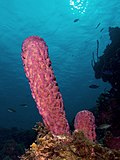The mesohyl, formerly known as mesenchyme or as mesoglea, is the gelatinous matrix within a sponge. It fills the space between the external pinacoderm... 2 KB (227 words) - 17:40, 11 January 2024 |
functions as a hydrostatic skeleton. It is related to but distinct from mesohyl, which generally refers to extracellular material found in sponges. The... 6 KB (678 words) - 17:11, 13 January 2024 |
 | Mesohyl Pinacocyte Choanocyte Lophocyte Porocyte Oocyte Archeocyte Sclerocyte Spicule Water flow Choanocytes (also... 3 KB (349 words) - 11:52, 20 May 2023 |
adhesion, signaling, phagocytosis, and polarity. Pinacocytes are filled with mesohyl which is a gel like substance that helps maintain the shape and structure... 3 KB (266 words) - 08:03, 15 November 2023 |
found in sponges. The sponge body is mostly a connective tissue; the mesohyl, over which are applied epithelioid monolayers of cells, the outer pinacoderm... 2 KB (181 words) - 03:30, 16 March 2024 |
collencytes and structural elements called spicules. They move about within the mesohyl with amoeba-like movements performing a number of important functions.... 2 KB (224 words) - 13:33, 19 July 2022 |
 | sponges, amebocytes, also known as archaeocytes, are cells found in the mesohyl that can transform into any of the animal's more specialized cell types... 4 KB (378 words) - 11:14, 23 January 2024 |
 | have a non-living mesohyl layer that is located between the two living layers. Despite being made up of non-living material, the mesohyl contains living... 19 KB (2,011 words) - 15:31, 22 April 2024 |
 | of Porifera. The diagram shows the mechanism of water uptake for sponges. Yellow: pinacocytes, red: choanocytes, grey: mesohyl, pale blue: water flow... 57 KB (6,610 words) - 14:57, 23 February 2024 |
just the external tubes) and the largest tip penetrates the cormus. The mesohyl is full of bacteria. Klautau, Michelle; Valentine, Clare (2003). "Revision... 2 KB (167 words) - 04:08, 24 November 2023 |
body. Between the two layers a more or less gelatinous substance called mesohyl. Sclerocyte cells are responsible for secreting a kind of skeleton for... 4 KB (378 words) - 08:20, 30 April 2024 |
form the cormus. The spicules are very bright and can easily be seen. The mesohyl has many porocytes with brown granules. The skeleton has no special organization... 3 KB (216 words) - 17:47, 5 February 2024 |
sponges they secrete calcareous or siliceous spicules which are found in the mesohyl layer of sponges. The sclerocytes produce spicules via formation of a cellular... 2 KB (180 words) - 19:49, 11 July 2023 |
 | areas the tubes are hispid. Cells with yellow granules are present in the mesohyl, as are embryos, which are always found near choanocytes. The cells with... 16 KB (840 words) - 16:03, 1 March 2024 |
areas the tubes are hispid. Cells with yellow granules are present in the mesohyl, as are embryos, which are always found near choanocytes. The cells with... 3 KB (307 words) - 04:54, 8 March 2021 |
 | abundant microorganisms in the highly diverse microbiome of the sponge mesohyl. They have been found in a large variety of sponge species from diverse... 9 KB (928 words) - 01:47, 1 May 2024 |
 | of the shell. Sponges are known to hold mutualistic bacteria in their mesohyl. S. domuncula produce a bacterial quorum sensing molecule,... 12 KB (1,333 words) - 03:32, 19 February 2024 |
 | (2008). "Identification of the bacterial symbiont Entotheonella sp. in the mesohyl of the marine sponge Discodermia sp". The ISME Journal. 2 (3): 335–339... 4 KB (334 words) - 07:47, 2 April 2024 |
 | each, and many small inhalant pores on the sides of the papillae. The mesohyl, a jelly-like layer in the body wall, is stiffened by mineral spicules... 5 KB (500 words) - 18:51, 1 November 2021 |
 | together so water moves throughout the specimen. The tissue is called the mesohyl and the water movement occurs through flagellated cells called choanocytes... 5 KB (616 words) - 15:57, 22 April 2024 |
etheria. Through the collection and storage of spicule fragments within the mesohyl, D. etheria is capable of deterring predators. The production of toxins... 10 KB (1,167 words) - 15:13, 16 April 2024 |
all derived from epithelial cells and does not involve the migration of mesohyl cells (the gelatinous matrix in the interior of the sponge) into the bud... 5 KB (531 words) - 08:55, 19 November 2021 |








